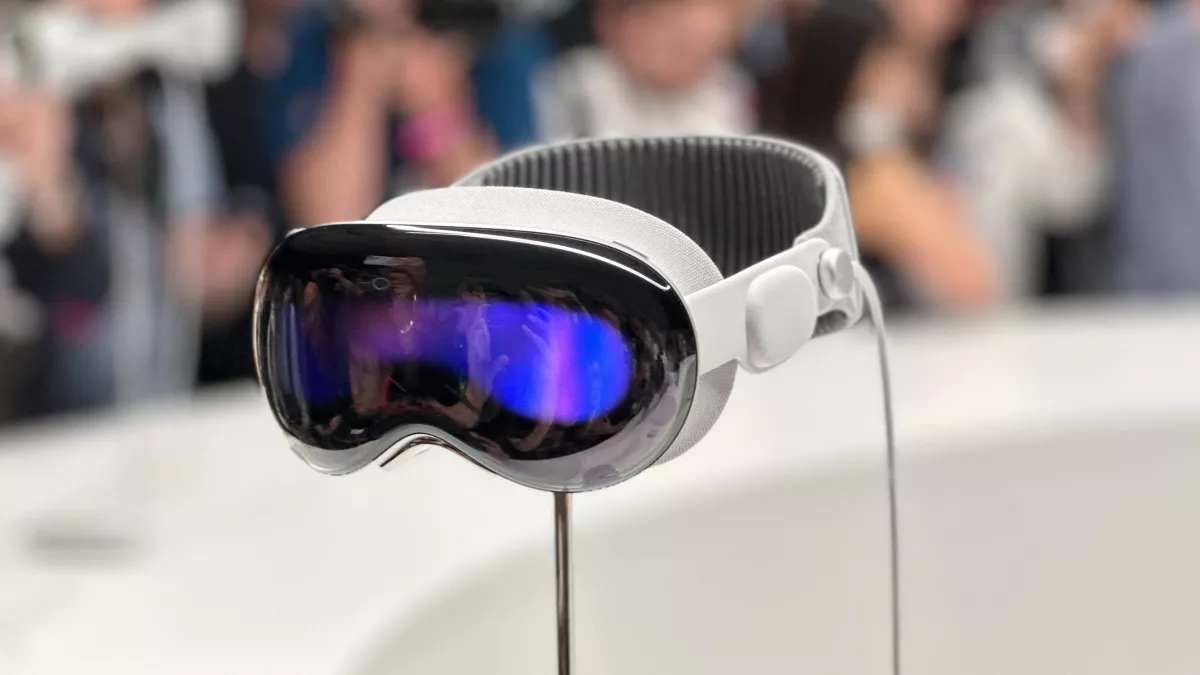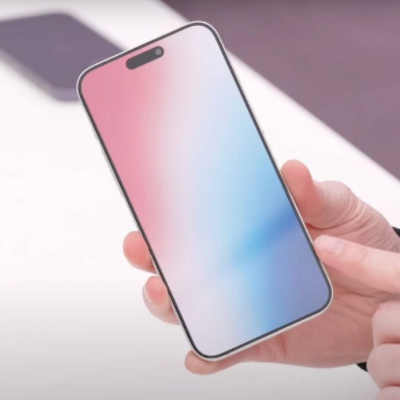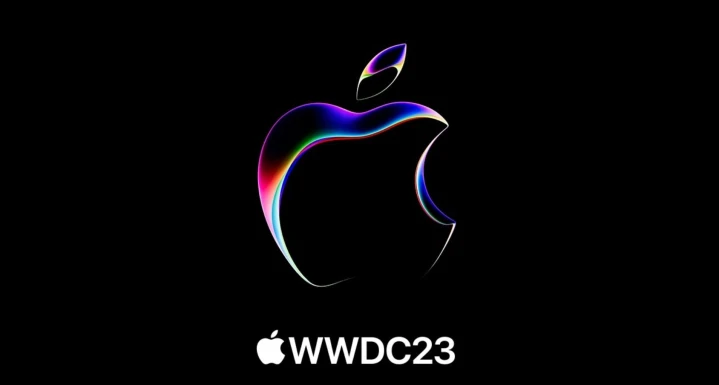
As regular as the tides, Apple’s Worldwide Developer Conference (WWDC) has become a big and highly anticipated part of our calendar. As is usual, this year’s keynote announcements will include all the usual improvements for iOS, iPadOS, watchOS, macOS, and more — but this year is also different, thanks to the reveal of a brand new area for Apple, the Vision Pro headset.
The keynote was jammed full of content, as usual, and there’s plenty to talk about. Here’s a recap of everything Apple announced at WWDC 2023!
Vision Pro VR headset

An Apple-branded augmented reality/virtual reality has been rumored for years and years, but it’s finally here. The final part of the WWDC keynote was dedicated to the Vision Pro AR headset, and Apple really went in-depth, offering insights into the many possible uses for the new product — which is understandable, as it’s one of Apple’s biggest new launches since the original Apple Watch.
It’s important to note that this product is not the long-awaited Apple-branded smart glasses, which are a purely AR experience and will probably look like a regular pair of glasses. Instead, the Vision Pro is a VR headset set to compete with the Meta Quest 3 and PlayStation VR2 and sports a similar style, with a broad visor and full head strap.
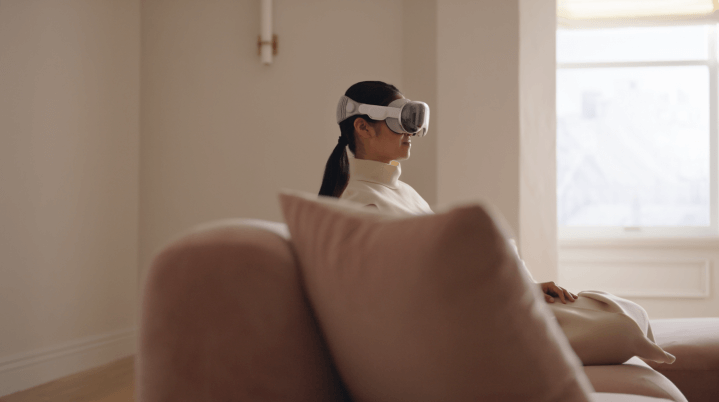 Except, it’s not exactly the same as its competitors. Most VR headsets are big and heavy items, and it’s clear a slim build and light weight were top of Apple’s goals with this headset. Light materials have been used wherever possible, with more premium and heavier materials only used where absolutely necessary — like the front of the device, which is entirely glass. There’s a Digital Crown on the Vision Pro, too, borrowed from the Apple Watch to provide a small element of physical control. The headset’s frame bends slightly to fit around your face, while the band has been designed to be as comfortable as possible. Inserts can be added for those who use glasses, while the battery is connected by wire and can be slipped into a pocket so it doesn’t weigh down the headset. There are no controllers. Instead, the Vision Pro is controlled by your voice, hands, and eyes.
Except, it’s not exactly the same as its competitors. Most VR headsets are big and heavy items, and it’s clear a slim build and light weight were top of Apple’s goals with this headset. Light materials have been used wherever possible, with more premium and heavier materials only used where absolutely necessary — like the front of the device, which is entirely glass. There’s a Digital Crown on the Vision Pro, too, borrowed from the Apple Watch to provide a small element of physical control. The headset’s frame bends slightly to fit around your face, while the band has been designed to be as comfortable as possible. Inserts can be added for those who use glasses, while the battery is connected by wire and can be slipped into a pocket so it doesn’t weigh down the headset. There are no controllers. Instead, the Vision Pro is controlled by your voice, hands, and eyes.
This headset is an extremely high-end entry in VR headsets, too, with each of the two displays containing more pixels than a 4K TV for unmatched crispness. It’s powered by Apple’s powerful M2 processor., the same chip you’ll find in the latest Macbook Pro 13-inch laptops, and it’s backed up by a new R1 chip created especially for the Vision Pro. It makes sure images are sent to the display in a seamless manner, eradicating frame lag that would impair the experience and freeing up the M2 to handle the other processing.

A blend of augmented reality (AR) and virtual reality (VR), the Vision Pro is the first Apple product you look through rather than at. Apple is clearly intending the headset to be an extension of your existing Apple ecosystem. As such, the Vision Pro has all the same Apple apps as your iPhone and can access your photos, videos, and call contacts.
The array of sensors and cameras on the front of the device means you can see your home through the Vision Pro, much like the Meta Quest’s Passthrough feature. Apple intends for you to use this around your house as a place to construct your own augmented reality space. Apps can be placed in physical space and expanded or shrunk to your needs, and they can be anchored in place so they don’t move when you do. Would you rather the real world fade away? You can add an immersive landscape experience instead of the real world, transporting yourself to a number of places, and can fine-tune your immersion level (i.e., whether you want it to be slightly transparent or not) using the Digital Crown.
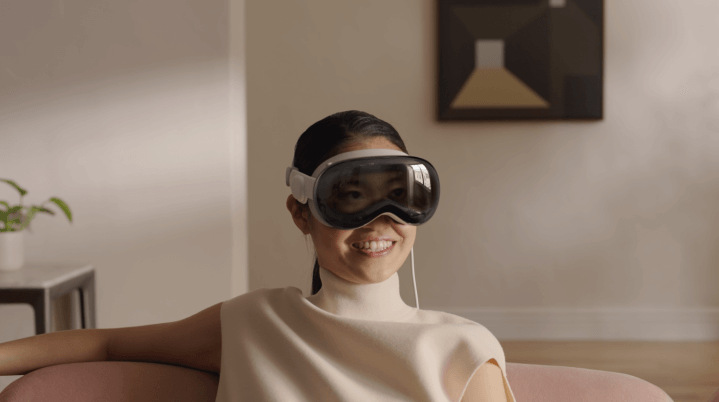
Incredibly, that passthrough of information extends to you. Using internal cameras and sensors, a live feed of your eyes can be displayed on the Vision Pro and indicates when you’re using Eyesight to see through your headset’s cameras. This means those around you can see your eyes, even while using the Vision Pro. This is a massive deal in the VR space, as it stops users from being as locked out as they are in other headsets … even if it does look a little “uncanny valley.” Those same cameras and sensors are also being used for security, which is, as ever for Apple, a big part of the Vision Pro. The headset will use your eye’s unique iris information to unlock your device, a feature Apple is calling Optic ID.
As you’d expect, the Vision Pro works well with existing Apple accessories. The Magic Keyboard functions within Vision Pro, and incredibly, so does your Mac. Load up your Mac, and it can spring to life within Vision Pro, giving you a much larger screen to work with. Apple boasts this will work well within an office environment, whether in person or when working from home. After work, you can load up a streaming service and immerse yourself into a 3D movie on an incredibly rendered 100-foot screen.
3D motion on videos and spatial audio means memories and experiences will be even more immersive than ever on Vision Pro and can be captured directly from the Vision Pro for experiencing later. Vision Pro also supports Apple Arcade games and comes with PlayStation DualSense controller support, making it the one-stop space for work and play. Over one hundred games will be ready for Vision Pro on launch.

Another surprise guest for the keynote, Disney’s Bob Iger, dropped by to endorse the Apple Vision Pro and announce Disney support. Disney Plus app support will be available from day one, but for now, the deeper implications of Disney’s and Apple’s partnership remain to be seen. A speculative video teased some features that Disney is apparently working on and included additional context windows when watching Disney shows, special Disney VR environments, the ability to watch sports games from inside the arena, interact with Marvel’s What If series, and more.
Apple clearly has a vision for the Vision Pro, with the presentation being chock full of people using the Vision Pro while packing for trips, fetching drinks from the fridge, and even playing with their kids. The small dimensions and weight of the device mean Apple is clearly hoping this will be a device people will be able to put on and keep on for a long time and not just use in short spurts. In short, Apple wants the Vision Pro to be as big a part of your life as your iPhone.
The price is a big hurdle for that goal, though. The Apple Vision Pro starts from $3,499, a far cry from the much more reasonable price of other AR/VR headsets. The Apple Vision Pro will be available in 2024.
15-inch MacBook Air

Apple kicked off WWDC by introducing a new Macbook Air, a 15-inch variant of the regular 13-inch Macbook Air. Apple claims it’s the world’s best 15-inch laptop, with a thin and light but durable design, an extremely powerful Apple M2 processor, and a gorgeous 15.3-inch Retina display. If you’ve seen and used an M2 Macbook Air 13-inch, then imagine that, but bigger. It comes in four colors and comes with the MagSafe charging port, two USB-C ports, and a headphone jack. The display tops out at 500 nits of brightness and has a 1080 webcam above and six spatial speakers below. Apple claims it will have 18 hours of battery life.
The Macbook Air 15 will cost $1,299 ($1,199 for educators). The M2 Macbook Air 13 will get a small price drop to celebrate, falling to $1,099, while the M1 Macbook Air will fall to $999.
New Mac Studio and Mac Pro

The professional-but-tiny Mac Studio is getting new versions using Apple’s most powerful new cores. There’s now an M2 Max and M2 Pro version of the Mac Studio, but the new Mac Studio will also sport a brand new Apple chip — the Apple M2 Ultra. Basically, two M2 Pro processors stuck together, the M2 Ultra is a stunningly powerful chip and is capable of 22 streams of 8K ProRes footage in Final Cut Pro, and is 6x faster than the fastest Intel-powered Mac Pro.
The Mac Studio isn’t the only Mac product getting the M2 Ultra. There’s a new Mac Pro with the M2 Ultra as well, giving the Mac Pro a much-needed and powerful upgrade to a 24-core CPU and a 76-core GPU. This new Mac Pro has eight Thunderbolt ports, six expansion slots for customization, and it comes in both tower and rack mount enclosures.
The M2 Mac Studio starts from $1,999, while the M2 Ultra Mac Pro starts from $6,999. Preorders open today, with shipping starting next week.
iOS 17
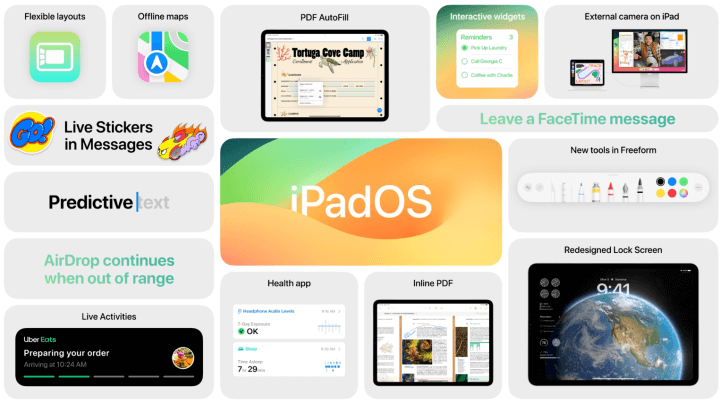
As has become tradition, the new version of iOS was a key part of the WWDC keynote. There’s no big headline-grabbing feature this time around, with Apple focusing largely on quality-of-life improvements over fancy new additions, but even with that in mind, there are plenty of reasons to be excited about iOS 17.
iOS 17 will add personal contact “posters” when called by specific contacts, giving you the ability to customize your contact screen the same way you’d customize your lock screen. That’s not the only part of the Phone app being updated, as Apple is also adding Live Voicemail. This feature, similar to the Google Pixel’s Call Screen, offers a real-time transcript of a voicemail, so you can choose whether or not you want to pick up a call. Finally, FaceTime is also getting video voicemails, so you can leave a message for someone even if they’re not available at that moment in time.
Messages is getting a few upgrades too. You’ll be able to create search filters and get a catch-up arrow to jump to where you left off in a particular chat, so you don’t have to keep scrolling to get back to where you left off. Messages is also getting a live location feature, which comes hand-in-hand with the new Check-In feature. Check-In is a safety-conscious feature that lets specific contacts know when you get home safely, and it’ll also let specific contacts know if it seems as if something has gotten wrong on your way home.
On a lighter note, the Sticker feature has been expanded with a new Sticker drawer, the conversion of all emojis into Stickers, and the ability to use Stickers anywhere on iOS.
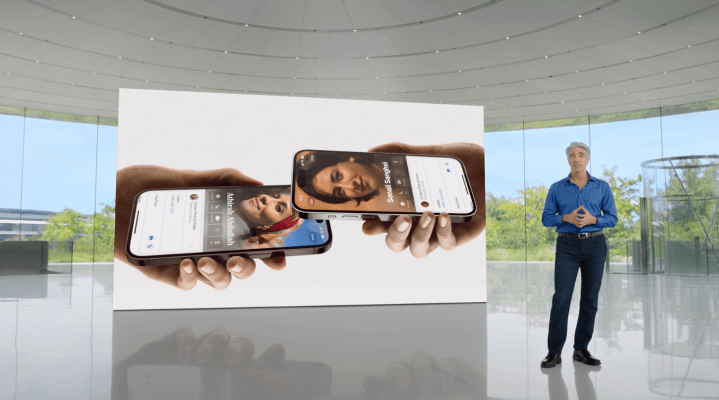
AirDrop on iOS 17 will support NameDrop, a new way of transferring contact information between iPhones. To use it, simply place your iPhone near another and choose which contacts to transfer. It’ll even work with an Apple Watch. AirDrop will now also continue transferring over mobile internet if you leave AirDrop range.
The keyboard’s autocorrect is getting supercharged, with more intelligent corrections and automatic word learning for a more personal touch. Dictation will also benefit from these changes, making it more accurate.

Apple leaned hard into the lock screen changes last year, and iOS 17 is building even further on that. In iOS 17, your iPhone’s lock screen will morph into a smart home display-like state called Standby. When it’s not in use and in a horizontal orientation, it’ll show the weather, upcoming appointments, notifications, and other important information. Apple’s aim is to make your iPhone more useful even when you’re not using it, and it helps to fill a smart display-sized hole in Apple’s Homekit offerings. Siri works in Standby by just saying “Siri,” and it adapts for nighttime as well, shifting into a less intrusive red light.
The developer beta for iOS 17 is available today, with a public beta coming next month and a full release in the fall.
Journal app
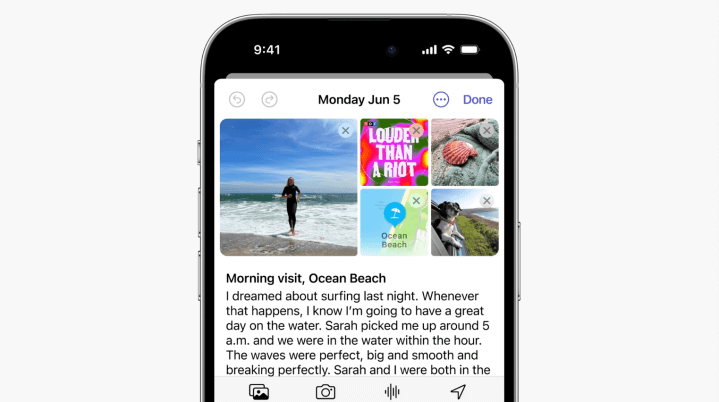
One of the more surprising additions to iOS 17 is the Journal app. Essentially a diary app cranked up to 11, Apple’s new app will use machine learning to prompt users to add the details of their day, along with their thoughts and feelings.
Photos and Maps will be integrated into the experience, providing additional prompts and content for your daily entries. All processing will be done on-device in order to ensure user security. Journaling is a well-known mindfulness technique, so it’s easy to see this as Apple pushing further into the physical and mental health world. We’re excited to try this out.
iPadOS 17

Apple iPadOS 17 will be getting a lot of the same updates and tweaks as iOS 17 but with a few additions just for the large-screened operating system.
Widgets are getting improvements in iPadOS 17, and you’ll be able to quickly interact with any widget on your home screen without needing to shift to the widget’s app. Lock screen customization is also arriving on iPadOS 17, and it means you’ll be able to customize your iPad’s lock screen to match or contrast with your iPhone’s lock screen, with the benefit of seeing it on a much larger screen. Live Activities is also coming to iPadOS’s lock screen, as well as the ability to show multiple timers at once.
One of the biggest and best improvements to iPadOS, though, has to be the addition of the Health app. Apple provides a lot of health data, so it’s great to have the large screen of an iPad to really dive deep into your latest workouts, health reports, and more.
PDF support is getting improved too, and now iPads will be able to detect the text entry portions on a PDF, giving you the ability to quickly and easily fill in the entries you need to complete before sending it off. PDFs will now also be stored within the Notes app, giving you unparalleled ability to store multiple PDFs within a single note or work with someone else on the same information using Live Collaboration.
The developer beta is releasing today, while a public beta will come next month, and the final release dropping in the fall.
macOS Sonoma
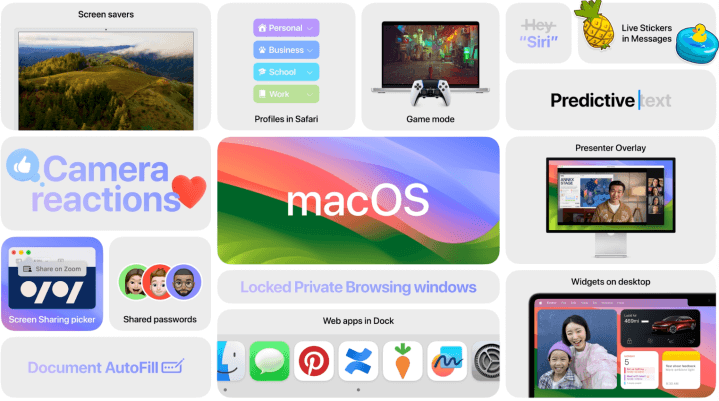
As expected, the new version of macOS debuted at the WWDC Keynote. Named macOS Sonoma, this new update includes a lot of the new additions coming to iOS and iPadOS. Sonoma includes a number of stunning new video screensavers which slowly scroll across gorgeous scenes from around the world.
Do you love widgets? We do, and so does Apple. Sonoma is adding the ability to add widgets directly to your desktop. You can add them wherever you like, and they intelligently adapt to what you’re doing on your Mac at any time. They’ll change color depending on your wallpaper, and when you’re using an app, they’ll fade into the background so they’re less distracting. Like iPhone and iPad, Sonoma’s widgets are fully interactable directly from the desktop.
Gaming hasn’t traditionally been macOS’s strong suit, but Apple’s M-series processors are changing that. Sonoma is getting a Game Mode, which optimizes your Mac to run games, reducing non-game processes to make sure your Mac runs your games in tip-top condition. That wasn’t everything on the gaming side, too. Legendary game director Hideo Kojima made a surprise appearance to announce that the Death Stranding Directors Cut would be coming to Macs later this year.

MacOS isn’t all play and no work, too. A presenter overlay will pop up during video presentations, giving you more immediate feedback on your current presentation, while watchers will be able to respond to your presentations with interactive reactions. These will work on most video presenting platforms, including Zoom and FaceTime.
Some additional updates for Safari will now allow for secure password sharing and introduce a new Profile system, which will allow you to separate your browsing history and cookies between work and play or just between users on a single machine. If you use specific websites a lot, the new WebApp feature can turn those websites into a pseudo-app interface, removing the website from Safari and giving it its own specific window.
Sonoma’s developer beta is available today, while the public beta comes in July. As with the other software announced today, a full release will arrive in the fall.
Audio and video updates

The most popular headphones in the world, the AirPods, are getting new abilities. Adaptive Audio combines Noise Cancellation and the Transparency mode to intelligently adapt and swap between audio modes when required. So distracting noises will be tuned out, while anything important will be highlighted. Conversation Awareness plays into this by automatically lowering the music volume when it detects you’re starting to talk to someone and focusing the Transparency mode on the person you’re talking to.
AirPlay is also being improved. AirPlay will learn when and where you tend to use your different Airplay devices and will start to offer AirPlay ahead of time. AirPlay in Hotels is another new addition, which will allow for quick and easy pairing to specific hotel sound systems.
Apple’s TV operating system, tvOS, wasn’t left out. tvOS’s control center has been improved, making it easier and quicker to use. Your iPhone can also be used to find your Siri Remote, reducing that annoying time spent hunting for a remote. The most exciting addition to tvOS, though, is the addition of FaceTime to Apple TV. You can quickly and easily send your FaceTime calls to your Apple TV, and all the usual features, like Center Stage, will work great on Apple TV’s FaceTime. You can even use SharePlay for the ultimate viewing experience with friends.
watchOS 10

Did you think you’d had enough customization? Well, you haven’t — because watchOS 10 is getting customization options too. The new version of watchOS will allow you to change any of your watch faces for your own personal needs by adding Smart Stacks with widgets that are accessible by just moving your Digital Crown. You can add or remove widgets with a long press, and you can quickly access your favorite apps directly from the Smart Stack.
Apple has also been working on cycling tracking, and watchOS 10 will now support Bluetooth bike sensors, so you can track your cadence and power using your Apple Watch. This is a big addition for cyclists, as it helps cut down on the number of devices needed when going out for a long ride. Apple Watch cycling workouts will now show up as a Live Activity on your iPhone automatically, so you can put your iPhone in a bike mount and keep updated with your Apple Watch’s stats as you cycle.
The Compass app is getting some great new safety options, including a pair of features that show where you last accessed cell connection, as well as the nearest location that can be used to send an SOS message. There’s also an elevation view and the ability to search for nearby facilities and hiking trails.
The Apple Watch will also now be able to analyze your tennis or golf swing and keep you updated as to how you’re progressing in your chosen sport.
Mental and physical health tools
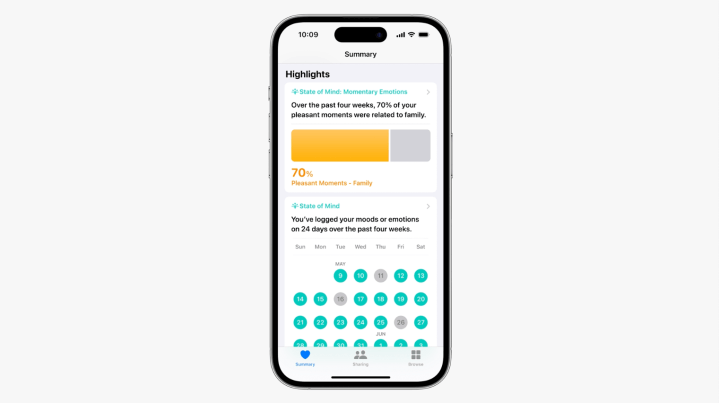
Having conquered the world of physical health, Apple now wants to shine a light on mental health. The Mindfulness app in watchOS 10, iOS 17, and iPadOS 17 will now be able to record how you’re feeling at any particular moment, as well as record what you think might be causing that mood.
Mindfulness will also use clinical questionnaires to help you stay on top of your mental health and will even let you know if it thinks you may need to speak to someone about your health.
Myopia (short-sightedness) has been a particular focus for Apple this year, and now, watchOS 10 will track the time spent in daylight for kids, which has been proven to help reduce the chances of myopia development in children. Also included is a feature that will measure the distance at which your child uses their iPad or iPhone, another key indicator of potential myopia.


